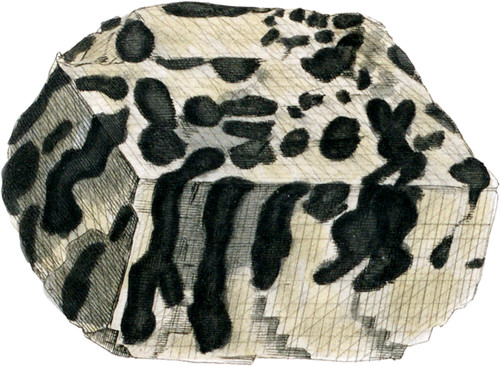 Enlarge
Enlarge
Exotic Mineralogy
Ore of Selenium
- See Thomson’s Annals, Vol. II. p. 449.
The only mention we have in England of the ore that contains the extraordinary new metallic substance discovered early last year, by Professor Berzelius, in the sulphur procured in roasting the Pyrites of Fahlun, and which is used for the manufacture of sulphuric acid at Gipsholm, is contained in an extract of a letter, from the Professor to Dr. Mareet, which is inserted in Thompson’s Annals, as quoted above; it is as follows: “With respect to Selenium, I must inform you that I have found a fossil which contains one-fourth of its weight of it. It had been for a long time considered as an ore of Tellurium. I made an analysis of it some time ago; I could not find any Tellurium in it, but the blow-pipe always afterwards retained the odour of this metal. During my researches on Selenium, I recollected this circumstance, and the friend who possessed the mineral, sent me a sufficient quantity for an exact analysis. I find it to be composed of one atom of Selenuret of Silver, and two of Selenurct of Copper.” In this account we have no description of the mineral, but the specimen here figured was presented to the British Museum, as a Selenuret of Copper and Silver, by Berzelius himself, and is supposed to be the same ore above mentioned.
The principal mass is Carbonate of Lime, with the cleavage very regular, and the faces strongly marked with diagonal striae. The metal appears in a state of very minute division, dispersed in elongated black clouds through it, without interrupting the flatness of the laces and only perceptible as a distinct substance in two or three fissures or porous parts of the specimen, where it occurs in very minute grains of the lustre and colour of tin.
The following are a few of the peculiarities of the new metal as collected from Berzelius’ letters in Thompson’s Annals. It is of a grey colour, with a high metallic lustre, or if minutely divided of the colour of Cinnabar, it is a non-conductor of heat and electricity; it has a scarcely perceptible transparency. It is easily melted, and while cooling, may be drawn out into fine threads, that appear of a ruby colour by transmitted light while by reflected light they exhibit a brilliant metallic lustre. It is volatile at a temperature approaching that of boiling Quicksilver; when heated by a candle, it burns with an azure-blue flame, exhaling a strong odour of Horseradish. It combines with Hydrogen, forming a similar compound to Sulphurcted Hydrogen Gas, but so excessively pungent, that the Professor, having breathed a bubble of it no larger than a small pea, felt a painful sensation, was seized with a giddiness, that however soon left him and remained insensible to the scent of the strongest Ammonia, the inflammation and a catarrh that followed the inspiration, lasted a considerable time.
Selenium also combines with many of the other metals; with sulphur, alkalies, earths, wax, and fat oils, it forms red compounds, and is soluble in several acids. It also combines with oxygen, producing an acid that will form specific salts with alkalies, earths, and metallic oxides. Zinc precipitates Selenium of a red colour, but in its metallic form from muriatic acid.
It is highly probable that some other ore of this extraordinary substance will be found; at present its rarity renders the one figured, it being the only specimen in England, highly interesting.

